#Crown Prince Naruhito
Explore tagged Tumblr posts
Text

30 April 2013 | Crown Prince Naruhito and Crown Princess Masako of Japan leave following the inauguration ceremony for HM King Willem Alexander of the Netherlands, at New Church in Amsterdam, Netherlands. (c) Carl Court - Pool /Getty Images
#Crown Princess Masako#Empress Masako#Crown Prince Naruhito#Emperor Naruhito#Japan#wax&max#2013#Carl Court#Pool#Getty Images
5 notes
·
View notes
Text





Japanese Imperial Family - Emperor Naruhito and Empress Masako with members of the Imperial Family attends the Autumn Garden Party at Akasaka Estate in Tokyo, Japan (Photos by Tatsuya Fujii) | October 30, 2024.
#royaltyedit#theroyalsandi#empreror naruhito#empress masako#crown prince fumihito#crown princess kiko#princess aiko#princess kako#princess hitachi#princess tomohito#princess akiko#princess yoko#princess tamako#princess tsuguko#japanese imperial family#autumn garden party 2024#oct 2024#2024#my edit
76 notes
·
View notes
Text
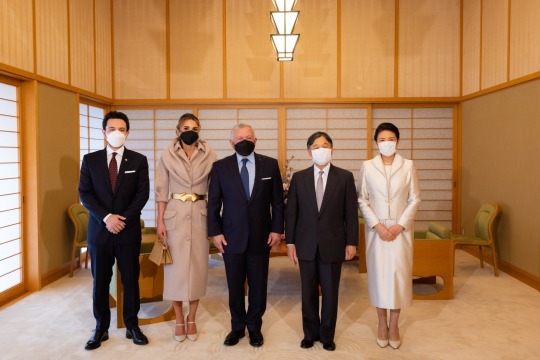
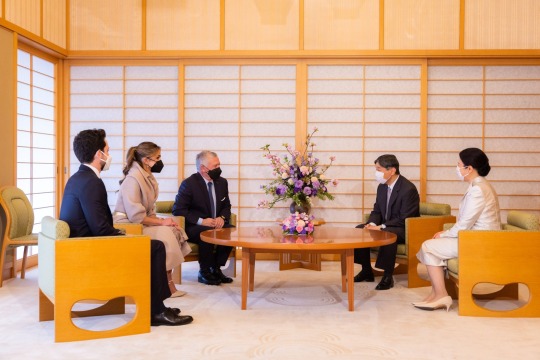
Emperor Naruhito and Empress Masako of Japan receive King Abduallah, Queen Rania and Crown Prince Al Hussein of Jordan as they are making an official visit to the country | April 11th, 2023
#emperor naruhito#empress masako#jif#king abdullah ii#queen rania#crown prince hussein#jrf#april 2023
23 notes
·
View notes
Text

Prince Hisahito, second in line to Japan's Chrysanthemum Throne, turned 18 on Friday, becoming the first male imperial family member to reach adulthood in about 39 years, highlighting the dwindling number of heirs to the world's oldest monarchy, Kyodo News reported.
The prince, nephew of Emperor Naruhito and son of Crown Prince Fumihito, joins a shrinking pool of adult royals as Japan's Imperial House Law restricts succession to males and requires female members to relinquish their titles upon marrying commoners.
"I aspire to grow through diverse experiences, absorbing various perspectives along the way," Prince Hisahito said in a statement released by the Imperial Household Agency, Japan's royal administrative body.
The prince's coming-of-age ceremony will be delayed until spring 2025 or later to avoid interfering with his studies at a Tokyo high school affiliated with the University of Tsukuba, the agency said.
With only three eligible heirs - Crown Prince Fumihito, Prince Hisahito, and the emperor's 88-year-old uncle Prince Hitachi - concerns about the imperial family's future have resurfaced. Previous attempts to reform succession rules, including proposals to allow female monarchs or retain women in the family after marriage, have stalled in recent years.
Prince Hisahito, known for his interest in natural history, co-authored an academic paper on dragonflies last year. The agency said he is "studying hard" to enter a university aligned with his interests while gradually taking on more royal duties.
The total number of imperial family members now stands at 17, with 12 being women, underscoring the challenges facing Japan's royal institution as it navigates tradition and modernization in the 21st century.
Source
#prince hisahito#japanese imperial family#Japanese monarchy#prince fumihito#princess kiko#japan#long live the queue
17 notes
·
View notes
Text
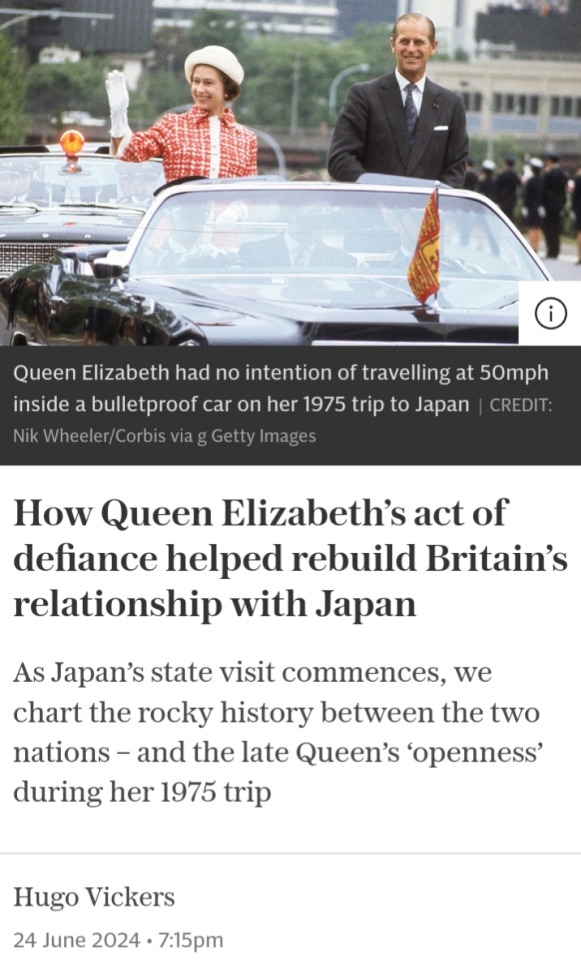
General elections are hardly famous for diplomatic exchanges.
But Rishi Sunak and Keir Starmer are sure to learn some lessons in pragmatism when Emperor Naruhito officially begins his state visit on 25 June.
What will they talk about if they attend the formal banquet at Buckingham Palace, as they are both expected to do, and at which they will perhaps be just a few seats apart?
Naruhito’s unexpected love of the Thames Barrier – he studied the history of cargo-carrying on the river during his spell at Oxford University – will surely appeal.
But the manner in which the British and Japanese royal families have rebuilt bridges after the deep scars of the Second World War might be a more illuminating place to start.
Those scars – the result of Japan’s crimes across the Asia-Pacific and the cruel treatment of British prisoners of war – had left a legacy of resentment that lasted long after the hostilities officially ceased in 1945.
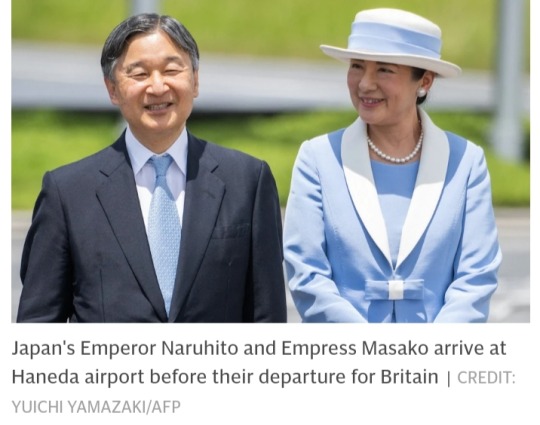
The pressure was on the young Queen Elizabeth II to restore good relations.
Though she rose to the occasion, making huge progress during her reign, the reconciliation was gradual to say the least.
In fact, when official diplomatic relations were restored in 1952, proceedings nearly fell at the first hurdle – over the Emperor’s Garter star.
When the new British Ambassador, Sir Esler Dening, presented his credentials to Emperor Hirohito, the Emperor’s household asked the British Foreign Office if he should wear what they called his “Garter rosette” when he received the ambassador.
The BFO said they preferred that this question had not been asked in the first place, given that Hirohito had of course picked the wrong side to align with during the war.
The exchange also highlighted what a delicate issue Garter honours had become.

To rewind: It’s a tradition for Japanese Emperors to be made British Knights of the Garter.
By 1952, three had had the honour:
Emperor Mutsuhito, who was appointed in 1906 in recognition of the Anglo-Japanese Alliance of 1902; Emperor Yoshihito in 1912, and his son, Emperor Hirohito in 1928.
Emperor Mutsuhito, who was lucky to be appointed in the first place, had never actually left Japan, and Edward VII did not want him to have it because Mutsuhito was a non-Christian monarch.
But Edward changed his mind after Japan’s 1905 victory over Russia and sent Prince Arthur of Connaught to Tokyo on a Garter mission to present the Emperor with the insignia.
Back then this journey was no trifle:
It took Arthur a month to sail from Marseilles to Yokohama to ask Mutsuhito to accept “the highest mark of friendship and esteem which it is in His Majesty’s power to bestow."
The Emperor was so delighted by the honour that he broke tradition and personally received him at the Imperial Palace.
Yoshihito made it out as far as Korea, but his disabilities and sickly disposition prevented him from much else.
His son Hirohito, meanwhile, was much more used to overseas visits.
He’d already visited Britain as part of a European tour in 1921, when he was a rather shy Crown Prince (the Duke of Windsor, as the Prince of Wales, visited Japan the following year).
After Hirohito succeeded as Emperor in 1926 he was appointed to the Garter, which was the cue for another long trip from England to Japan (this time by Prince Henry, Duke of Gloucester) to invest him.
But during the Second World War, Hirohito was regarded as an enemy alien, and his Garter banner was removed from St George’s Chapel and “placed in the vaults.”
Did he know of his demotion? Surely Dening would have maintained a dignified silence when he was pitching his ambassadorial services in 1952.
But the missing banner did cause minor concern ahead of Crown Prince Akihito’s visit to represent his father at the 1953 Coronation.
Luckily, when he laid a wreath in St George’s Chapel in honour of Queen Mary, who had lately died, he did not notice the absence of the Imperial banner.
Instead, his mind was on more youthful pursuits: during his visit, he was keen to go racing and attend Wimbledon.
Ever the astute hostess, the Queen duly invited him to the Derby.
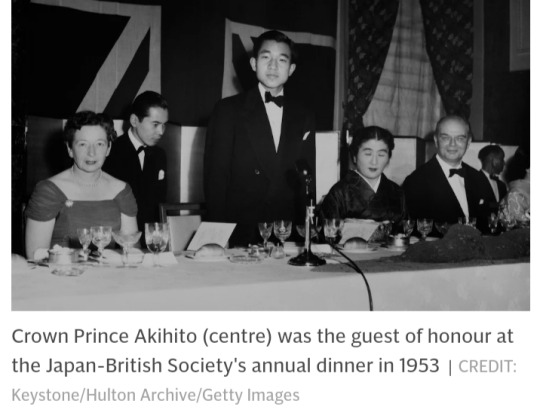
In those early post-war days, the bridge of cordiality that was slowly being built between Japan and Britain was as fragile as kintsugi porcelain.
A more important step towards reconciliation was needed and that came in 1961 when Elizabeth II’s cousin, Princess Alexandra, visited Japan.
She was accompanied by her mother’s private secretary, Sir Philip Hay, who had been a prisoner of war in the Far East, as a result of which he suffered recurring malaria.
Princess Alexandra found the Japanese very friendly but received letters asking why she had gone, since their families had suffered so gravely.
She told me that she gave him a “bottom scraper,” an unfortunately named device used for trawling the sea bed.
He was a marine biologist, having written several books on the subject and collected these objects.
Perhaps this inspired his grandson’s interest.
Whatever the Emperor made of his aquatic gift, he was undoubtedly more pleased by the fact that, during her visit, he was allowed to wear his Garter star.
During these and subsequent years, Princess Chichibu, the Emperor’s sister-in-law, worked tirelessly to improve Anglo-Japanese relations.
Her father had been Japanese Ambassador to Britain and she had been born in Walton on Thames.
With her husband, Prince Chichibu, she had attended the 1937 Coronation.
She became Patron of the Japan-British Society in Tokyo and had a prominent role during Princess Margaret’s visit for British Week in 1969.
At the time, Prince William of Gloucester even served at the British Embassy.
In 1970, King Charles III (as Prince of Wales) visited Japan, and the following year marked the first ever state visit by a Japanese Emperor to Britain when Hirohito landed on our shores once more.
When he accepted Queen Elizabeth II’s invitation, he addressed her as “Madam My Sister” and signed it “Your Majesty’s Good Brother.”
He added in his letter:
“I once visited your country when I was the Crown Prince and have always cherished the pleasant memories of it.”
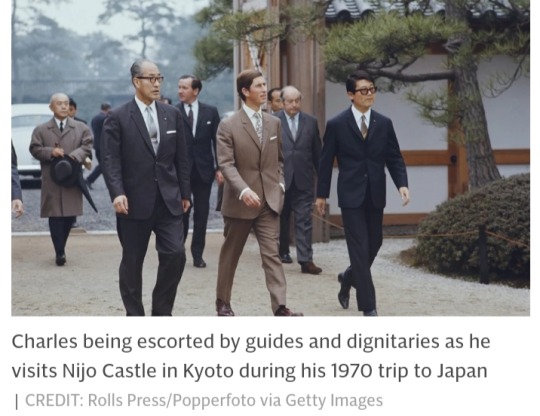
It was enough to restore his full diplomatic standing: he was quietly reinstated into the Order of the Garter, and a new banner raised over his stall.
The British newspapers were less forgiving:
Private Eye produced a particularly disparaging front cover, and David Walker, at the Foreign Office, wrote that his impression was “that the press became more hostile as the visit wore on.”
The public made their feelings known too: though the Emperor’s arrival at Victoria passed off smoothly, a man was arrested in the Mall for a mild incident, and a protester dug up the tree the Emperor planted at Kew.
Many more favourable column inches were devoted to the visit in the Japanese press, but the British Ambassador conceded: “the misdeeds of the past still remain alive.”
The return state visit by Queen Elizabeth II and Prince Philip in 1975 was a game-changer, however.
As part of it, the Queen wanted to drive through Tokyo in an open convertible Cadillac.
But Sir Fred Warner, the British Ambassador, was aware that there was “a tradition in Japan of political assassination” and that the Japanese police had a “proper fear” for the Queen’s safety.
President Gerald Ford had visited shortly before and had been guarded by an astonishing 160,000 Japanese police.
As Warner put it, “might as well have been wearing a cloak of invisibility.”
The original plan for the Queen was that everywhere she went, she should be driven at 50mph in a car with dark bullet-proof glass.
Unsurprisingly, this held no appeal for her: the Queen got her way and what became known as “the Open Car Drive” passed into Japanese history.
Since it passed off well, the Japanese police emerged as heroes of the plan.

The effect was that the Emperor, who led a somewhat cloistered existence, was impressed by the openness of the British Royal family.
The members of the Imperial family “felt that a window had been thrown open and a gust of fresh air let into their lives.”
On both sides, the overwhelming view was that the Queen’s visit, with its innovative approach to visibility, had “marked a significant step towards reconciliation and renewal of old friendships.”
Prince Philip played his part too, making a virtue of lying by omission.
During the state visit he was frequently asked: “Your first visit to Japan?”
“Yes”, he said.
In truth, he had been in Japan in 1945 at the time of the Japanese surrender.
When Emperor Hirohito died in 1989, Prince Philip volunteered to represent the Queen, feeling he was the right person to do so, since he had served in the war and did not mind any criticism that might come.
A decade later, in 1998, it was Hirohito’s son Akihito’s turn to pay a state visit to Britain.
But this time, the press were more pro-actively hostile: one TV station sent a car down to the house of a former POW to film him looking at his photos from the war.
They also took him by car to the Mall to film him setting fire to a Japanese flag – directing the cameras so that the state procession could be seen passing behind him.
This was despite the fact that Emperor Akihito, unlike his father, had played no part in the Second World War.
Akihito was given the Garter on his visit. Naruhito will also receive it on his.
He’s an Anglophile, having attended Oxford’s Merton College between 1983 and 1985.
During that time, while studying the waterways of Britain, he wrote:
“The name of the Thames conjures up in me feelings of affection and nostalgia transcending distance and time.”
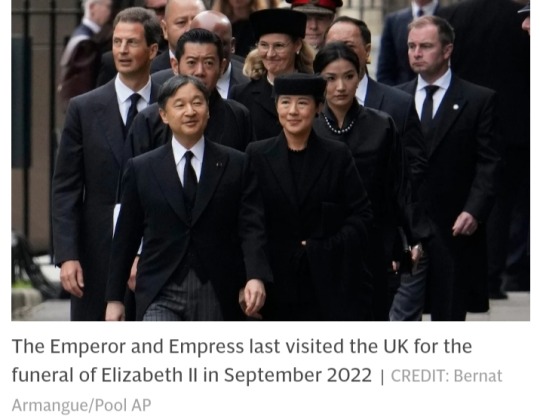
In 2006, King Charles wrote of “the close friendship between the United Kingdom and Japan, which is reflected in the solid bond between the Imperial and Royal Families.”
This visit will further cement that bond – something that the Emperor will reflect on when he privately visits St George’s Chapel at Windsor on June 27 to lay a wreath on the tomb of Queen Elizabeth II.
There, the Garter banner of his father will be above his stall, and the stallplates of his predecessors in their stalls – a permanent record of years of growing friendship.
#Emperor Naruhito#Empress Masako#Queen Elizabeth II#Prince Philip#King Charles III#Imperial House of Japan#Japanese Royal Family#British Royal Family#Japan State Visit 2024#Emperor Hirohito#Sir Esler Dening#British Foreign Office#Garter rosette#British Knights of the Garter#Emperor Mutsuhito#Emperor Yoshihito#Edward VII#Prince Arthur of Connaught#Prince Henry#Duke of Gloucester#Queen Mary#Princess Alexandra#Princess Chichibu#Princess Margaret#Prince William of Gloucester#Sir Fred Warner#US President Gerald Ford#Open Car Drive
15 notes
·
View notes
Text
Masterpost: Royal Authors
This is a text version of the original list I curated, which can be found here. The royals are listed chronologically based on their first name (not title). The books are listed with the oldest book first & most recently published book last.
Some of the mentioned people have published books or lent out their names for books as private citizens; this post & the original list only cover royal members & books published under their royal title. This means that some books & some people have been excluded due to not falling under those criteria.
Note: Some of the following links are affiliate links, which means I earn a commission on every purchase. This does not affect the price you pay.
Princess Akiko of Mikasa
Reconsidering early modern Yamato-e: perspectives from Japan, the UK, and the USA (2013)
Japan: Courts and Culture (2020)
Princess Alice, Duchess of Gloucester
The Memoirs of Princess Alice Duchess of Gloucester (1983)
Memories of Ninety Years (1991)
Catherine, Princess of Wales
Hold Still (2021)
Puzzles for Spies: The brand-new puzzle book from GCHQ (2022)
King Charles III
The Old Man of Lochnagar (1980)
Tomorrow is Too Late - A Celebration of Our Wildlife Heritage (1990) (with Sir David Attenborough, among others)
The Prince's Choice: A Personal Selection from Shakespeare by the Prince of Wales (1995)
Harmony: A New Way of Looking at Our World (2010)
Harmony: A New Way of Looking at Our World - Children's Edition
One Is Deeply Concerned: The Prince Charles Letters, 1969-2011 (2011)
The Prince's Speech: On the Future of Food (2012)
The list is too long; that man puts his name on literally everything. Check the page for more.
Princess Christina, Mrs Magnuson
Days at Drottningholm (2016)
Diana, Princess of Wales
British Sign Language: A Beginner's Guide (1988)
PEOPLE OF THE 90's: In Aid of the Malcolm Sargent Cancer Fund for Children (1995)
Hannah Riddell: An Englishwoman in Japan (1996)
Head Injury: A Practical Guide (1997)
King Edward VIII, Duke of Windsor
Launch! A Life-Boat Book (1932)
A King's Story: The Memoirs of the Duke of Windsor (1951)
The Crown and the People, 1902-1953 (1953)
Prince Edward, Duke of Kent
Jackie Stewart's Principles of Performance Driving (1986)
Australia Bound!: Story of West Country Connections, 1688-1888 (1988)
Deep into Blue Holes: The Story of The Andros Project (1989)
The Institution of Industrial Managers: A History 1931-1991 (1991)
The Story of E. H. Shepard: The Man Who Drew Pooh (2000)
Tribal Odyssey: A Photographic Journey Among Tribes (2000)
Chasin' the Sound: Tales and tunes from the career of Pipe Major Brian B Heriot, Scots Guards (2016)
A Royal Life (2022) (his memoir)
One Crew: The RNLI's Official 200-Year History (2024)
Queen Elizabeth, The Queen Mother
The Country Life Book of Queen Elizabeth The Queen Mother (1978) (actually by Charles & Godfrey Talbot, not her)
Henrik, Prince Consort
Fit for a Royal Dane: Gastronomic Views and Recipes of Prince Henrik (2002)
Meghan, Duchess of Sussex
Together: Our Community Cookbook (2018)
Princess Michael of Kent
Crowned in a Far Country: Portraits of Eight Royal Brides (1986)
Cupid and the King: Five Royal Paramours (1991)
The Serpent and the Moon: Two Rivals for the Love of a Renaissance King (2004)
A Cheetah's Tale (2017)
Princess Märtha Louise
Why Kings and Queens Don't Wear Crowns (2004)
The Spiritual Password: Learn to Unlock Your Spiritual Power (2014)
Emperor Naruhito
Costume at Castle Howard (1975)
The Thames and I: A Memoir of Two Years at Oxford (1993; 2006; 2019)
Queen Noor
Art of Jordan: Treasures from an Ancient Land (1991)
Landmines and Human Security: International Politics and War's Hidden Legacy
Leadership and the United Nations: The International Leadership Series (2003)
Leap of Faith: Memoirs of an Unexpected Life (2003)
Breaking Ground: From Landmines to Grapevines, One Woman's Mission to Heal the World: Transforming Mines to Vines (2020)
Prince Philip, Duke of Edinburgh
The Duke of Edinburgh's World Tour 1956-1957 (1957)
Selected Speeches 1948-1955 (1957)
Prince Philip speaks: 1956-1959 (1960)
Environmental Revolution: Speeches on Conservation, 1962-77 (1978)
Men, Machines and Sacred Cows (1984)
Down to Earth: Speeches and Writings of His Royal Highness Prince Philip, Duke of Edinburgh, on the Relationship of Man With His Environment (1988)
Survival or Extinction: A Christian Attitude to the Environment (1989)
The list is too long. Check the page for more.
Queen Rania
The Sandwich Swap (2010)
Prince William, Prince of Wales
Blown Away: From Drug Dealer to Life Bringer (2022)
Puzzles for Spies: The brand-new puzzle book from GCHQ (2022)
Earthshot: How to Save Our Planet (2021)
The Earthshot Prize: A Handbook for Dreamers and Thinkers: Solutions to Repair our Planet (2023)
(this post & the original list is a work in progress & will be updated whenever "new" books come on my radar)
#royal watching#literature#affiliate links#british royal family#japanese imperial family#swedish royal family#danish royal family#norwegian royal family#jordanian royal family
9 notes
·
View notes
Text

✵ June 9, 1993✵
Masako Osawa & Prince Naruhito, Crown Prince of Japan
Now The Emperor and Empress of Japan
11 notes
·
View notes
Note
For the coronation usually monarchs don't attend, but what about countries like Spain? They don't really have a heir of age that can attend and sending a former king and queen isn't a really good look...Or like Japan, Naruhito is an emperor and he outranks a king, but there are rumours that he at least will attend, so do you think that everyone will throw the "rule" out of the window and attend such a big party? hahaha
Yeah, I think the rule isn't as strict as people make it out to be and I'm not as sure as I was about who will be attending the coronation.
First there's the countries that are part of the Commonwealth and monarchies in their own right (Brunei, Eswatini, Lesotho, Malaysia, and Tonga) most of which sent the monarch not the heir in 1953. I would not be surprised if they did the same this time around. There are also more countries following the Dutch example of the monarch abdicating as a form of retirement so former reigning monarchs are in the mix in a way they weren't before.
Then you've got the young heirs. For Spain I think it will either be Queen Sofia or Queen Letizia. My dream would be for Queen Letizia to accompany Infanta Leonor since she's underage but both of them go. I wouldn't expect her to wear a tiara or anything and I know it's not going to happen but I can dream. There's also the heirs that are technically of age but still pretty young like Princess Catharina Amalia of the Netherlands, Princess Elisabeth of Belgium, and Prince Moulay Hassan of Morocco. I can't imagine being 19 and attending an event like this on my own. Are they going to send someone else with them or send someone else entirely?
Now we seem to have other sovereigns saying that they are planning on going. I was surprised when Prince Albert told People that him and Princess Charlene would attend because at the last British coronation Prince Rainier III sent his father, Prince Pierre, as Monaco's representative. I was expecting Princess Caroline to go but I'm hoping this means Princess Charlene will finally wear a tiara at a royal event.
A couple of weeks ago there was an article in Aftonbladet where Margareta Thorgren, the head of the Swedish Royal Court's press department, seemed to say that King Carl XVI Gustaf and Queen Silvia are planning to attend the coronation. I assumed that something got lost in translation but now I'm not so sure. They use kungaparet which means the king couple not kronprinsessparet which means the crown princess couple.
I Sverige kröns inte längre kungar, det började med att Gustav V avstod från ceremonin. I Storbritannien kröns däremot prins Charles den 6 maj i Westminster Abbey. Att kröningen kommer att bli lika spektakulär som när hans mamma, drottning Elizabeth, kröntes 1953 är inte troligt. Men det svenska kungaparet kommer att finnas på plats. Det är planen, säger Margareta Thorgren.
In Sweden, kings are no longer crowned, it started when Gustav V refrained from the ceremony. In Great Britain, on the other hand, Prince Charles is crowned on May 6 in Westminster Abbey. That the coronation will be as spectacular as when his mother, Queen Elizabeth, was crowned in 1953 is not likely. But the Swedish royal couple will be there. That is the plan, says Margareta Thorgren.
I didn't see the rumors of Emperor Naruhito attending but now that I read back how Prisma translated this article it does kind of sound like that's a possibility.

So I'm just really not sure about who we're going to see at the coronation.
83 notes
·
View notes
Photo

10 June 2013 | Prince Felipe of Spain receives Japanese Prince Naruhito at the El Pardo Palace on day one of a six day visit to Spain in Madrid Spain. Japanese Crown Prince Naruhito is on a six-day official visit to Spain to mark the 400th anniversary of bilateral ties between the nations. (c) Carlos Alvarez/Getty Images
#Crown Prince Naruhito#Emperor Naruhito#Prince Felipe#Prince of Asturias#King Felipe VI#Japan#Spain#2013#Carlos Alvarez#Getty Images
3 notes
·
View notes
Text





Japanese Imperial Family - Emperor Naruhito and Empress Masako departed from Tokyo's Haneda Airport for the United Kingdom. They were seen off by Crown Prince Akishino and Crown Princess Kiko. The official State Visit of Japan to the United Kingdom will begin on June 25. (Photo by Nishioka Shin) | June 22, 2024
#royaltyedit#theroyalsandi#emperor naruhito#empress masako#emperor naruhito of japan#empress masako of japan#japanese imperial family#my edit
89 notes
·
View notes
Text



It has been confirmed Crown Princess Victoria will attend the Coronation of King Charles III and Queen Camilla alongside her father. To my knowledge she has been to three previous enthronements and investitures: Prince Albert II in Monaco in 2005, King Willem Alexander and Queen Maxima in The Netherlands in 2013, and Emperor Naruhito and Empress Masako in Japan in 2019
#swedish royal family#crown princess victoria#prince daniel#king carl xvi gustaf#king carl gustaf#overseas#2005#2013#2019
45 notes
·
View notes
Photo
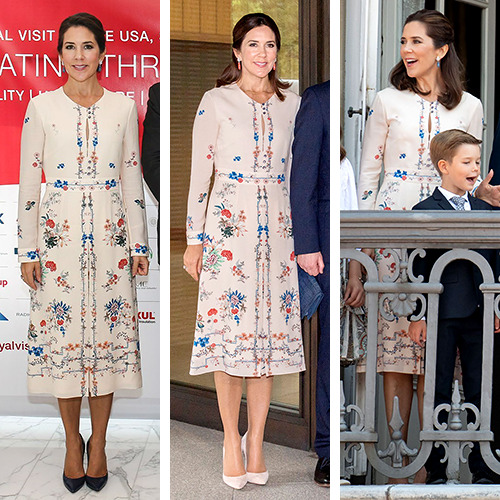
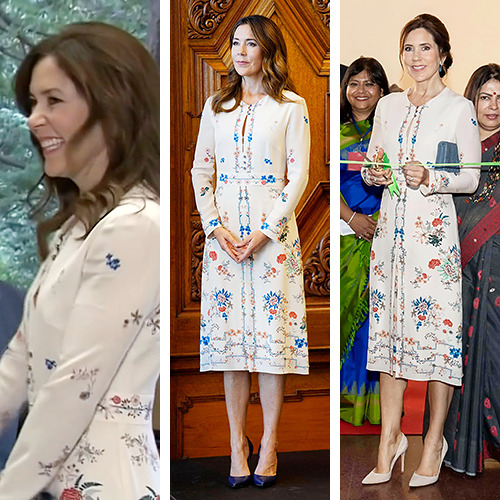
Crown Princess Mary’s recycling of the Vilshenko dress:
2016.09: Official Visit to U.S.
2017.10: Official Visit to Japan
2018.05: Crown Prince Frederik’s 50th Birthday
2019.10: Emperor Naruhito’s Enthronement
2020.09: Education Awards
2023.02: Official Visit to India
(updated from this post)
39 notes
·
View notes
Text
So I have a story to tell. Allow me, if you will, to take you on my rollercoater nightmare of trying to find a royal title that has never been used before in a language I do not speak.
I'm writing a YOI fan-fiction and as I am wont to do, I got far too invested in the little things that don't matter and probably won't even make it into the fic.
I was trying to find a Japanese title for "Emperor Consort". "Emperor" in Japanese is Tennō (天皇), with the first character translating roughly as heavenly and the second meaning sovereign. Now, Tennō is a gender-neutral term; Josei Tennō (女性天皇) is a term used to refer to empresses regnant, but this is apparently used retroactively to differentiate from male emperors, while Tennō would be used during their life.
Kōgō (皇后) is the term used to refer to a non-reigning empress consort. At first, I was hopeful that this was also gender-neutral, but I was getting a bad feeling when everything I could find only mentioned empresses. Of Japan's eight historically attested female emperors, none have been married during their reigns, I dropped that line of inquiry for now.
Next, I started looking into Aiko, Emperor Naruhito's daughter. Japan's post-Meiji succession rules prohibit women from ascending to the throne. After WWII, the rules got even more restrictive. All cadet branches of the Imperial House were required to renounce their titles, and even today when a princess marries she has to renounce her titles so her husband can't become the head of a new cadet branch. As a consequence, legitimate heirs can only come from male family members. These restrictive rules have led to something of a succession crisis. Emperor Naruhito only has a daughter, Aiko. His only brother Fumihito, the Crown Prince, has one (1!!!) son, Hisahito, 17 years old and second in line. Third in line is Emperor Emeritus Akihito's only brother Masahito, who is 88 years old and has no sons. And that's it.
This minor crisis has led to much talk about opening up the rules of succession so that women can inherit. If such a rule is implemented before Naruhito dies or abdicates, the throne will pass to Princess Aiko. There is actually strong support for Aiko-Tennō in Japan, about 88%, and there's even a manga, of all things, about it. Great, I naively think. All I have to do is search for whatever her prospective husband's prospective title will be. Sure, it might be a little hard because of the language barrier, but some thorough searching and a bit of google translate should do the trick.
Nothing. It didn't work. I tried switching from DuckDuckGo to Google Search. Nothing. I tried to track down that manga. It's only available in physical form. I try to track down Japanese language articles about the manga and translate them. Nothing. I try to find articles about the succession crisis. Nothing. I track down a 2005 Japanese government report on preparing for the possibility of changing the succession laws. The English language copy of the official advisory report says, "Under the current system, the consort of a (male) Emperor is titled Kōgō (皇后, Empress), and the widow of a (male) Emperor is titled Taikōtaigō (太皇太后, Grand Empress Dowager), or Kōtaigō (皇太后, Empress Dowager). The consorts of a Shinnō and of an Ō are titled respectively Shinnō-hi (親王妃) and Ō-hi (王妃). With the informed advice of learned individuals possessing an expert knowledge of the subject, appropriate titles will likewise need to be established for the consorts of female Emperors, Naishinnō, and Joō."
Cool. It would have been nice if you actually did that. Thanks for nothing.
At this point, I go back to my other idea of just using Kōgō. I don't think it will work, but is have to try. I already recognize 皇; I tracked down the meaning some time back, it roughly means sovereign. I try to track down the meaning of the other character 后. Wiktionary gives me monarch, ruler, sovereign, empress, queen, or other female monarch. I still have some gut skepticism. I go to the top of the page to find the etymology.
"Oracle bone inscriptions often wrote 后 as 毓, depicting a woman giving birth. Wang Guowei posits the meaning extended from childbirth to succession, then to empress. In the modern form, the birthing figure would be 𠂆 and the child figure 𠮛."
Fuck.
At this point, I am fully done. I've tried, and tried, and nothing has worked. This is unsurprising; an emperor consort is unprecedented in Japanese history. It's also unprecedented in Chinese history, so I can't even try to transfer a Chinese title into Kanji and then convert that into rōmaji. I even tried finding Korean and Vietnamese emperor consorts, both languages having used Chinese characters in the past. Nothing. I tried plugging variations of emperor consort into Google Translate. It just keeps spitting out 皇后. At this point, I have to admit defeat. It's over. I'm done.
I'm in bed at 00:00 when it hits me.
I open my phone.
I go to Wikipedia.
I search for Prince Consort.
I switch languages to Japanese.
I scroll down.
One section is titled 皇配.
皇
I recognize that symbol.
I open the section.
I see the English words empress regnant and emperor consort.
I Ctrl+C Ctrl+V 皇配 into Google Translate.
Emperor Consort. Romanized as Kōhai.
It was that fucking simple.
Fuck me. Fuck my brain for making me do this. I probably won't even use the goddamn title in my ENGLISH-LANGUAGE fanfiction. Fuck this, why did I do this to myself I'm an idiot god Fucking DAMN IT
Knowing me I probably won't even finish the fucking fic and it will never even see the light of day.
FIVE HOURS OF MY FINITE LIFE WELL SPENT!
I'm seriously so fucking pissed with myself.
#yoi#yuri on ice#fanfiction#fanfic#japanese#japanese language#i'm done#i'm so done#long post#long reads#victuuri#implied i guess
2 notes
·
View notes
Text

Princess Diana with then Prince Hiro, now Crown Prince Naruhito, at the Imperial Villa in Kyoto, Japan. May 1986
13 notes
·
View notes
Text





Emperor Naruhito and Empress Masako returned to Japan in the evening from their state visit to Indonesia. They were greeted by Crown Prince Akishino, Crown Princess Kiko and other officials. June 23, 2023.
📷 manichi.jp
8 notes
·
View notes
Text



4 June 1923
🇯🇵 Princess Yuriko of Japan, The Princess Mikasa
The Imperial Household Agency released a photo of Princess Yuriko who turned 100 years old today. She is the oldest living Royal in the world and the paternal great-aunt of the current Emperor, Naruhito. Her granddaughter, Princess Tsuguko, attended the wedding of Crown Prince Hussein wearing a lengthened version of her dress worn in 1988.
7 notes
·
View notes